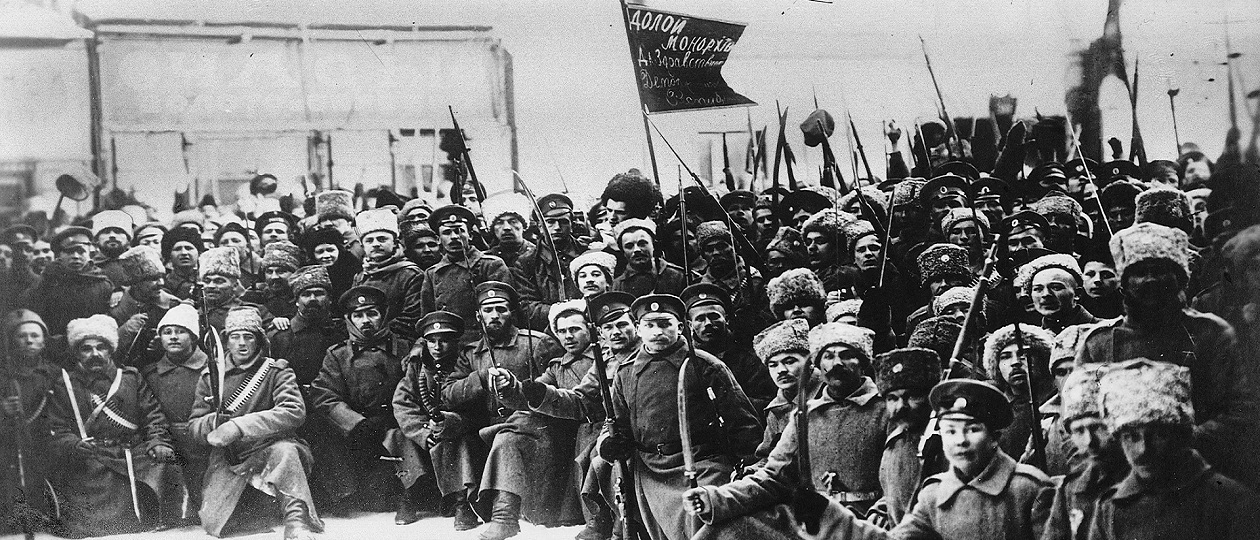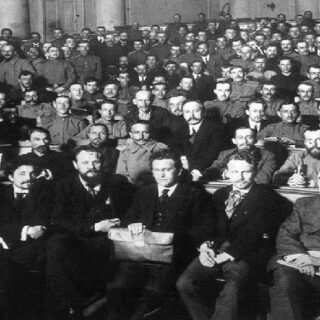
Just how unique were the Russian Revolutions of 1905-1907 and 1917-1922?
Both revolutions had their elements of uniqueness, but you can determine their uniqueness only by setting these revolutions in the entire history of European revolutions beginning with the revolution of 1768 in Geneva, Switzerland and finishing with the Russian Revolution of 1917-1922.
This means using a comparative approach in studying European and Russian revolutions from 1768-1922. Revolutions happen under specific historical conditions in different countries and regions during different historical periods. However, we can find elements of similarities and differences between revolutions provided we follow a precise methodology of comparison. [1] Otherwise, we wind up making false comparisons and conclusions.
Comparative studies of revolutions have been published for decades, but many studies contain simplified and outright mistaken interpretations. Soviet historians had a very simple comparative approach in studying revolutions. All revolutions before the October Revolution of 1917 were called bourgeois or bourgeois democratic. The Great October Socialist Revolution, in the opinion of Soviet historians, not only brought liberation to the working people of the Russian Empire, but also set the beginning for a powerful wave of leftist, anti-imperialist, and progressive revolutions throughout the whole world in the 20th century.
According to Soviet historians, reasons for the defeat and incompleteness of the bourgeois and bourgeois-democratic revolutions included: the betrayal by the bourgeoisie and petty-bourgeoisie, especially of the peasantry, of the revolutionary cause, the immaturity of the proletariat (working class), the harmful influence of petty-bourgeois socialist ideologies on the working class, the ability of the class enemies to sow discord and conflicts, especially ethnic-based, among the working people; the absence of a consolidated proletarian party (in other words, a Bolshevik or Communist party).
It is not surprising that the criticism and condemnation of non-Communist ideologies occupied a special place in the works of Soviet historians. According to Marxist-Leninist ideology, every ideology reflected the interests of a social class or a stratum within the class. Historians were responsible for showing the logically inevitable collapse of all non-proletarian (non-Communist) ideologies. [2]
Among all the revolutions before the October Revolution of 1917, Soviet historians made an exception for what they called the Great French Bourgeois Revolution of 1789-1799. They recognized the French revolution as the greatest bourgeois revolution in European history and agreed that in many ways it foreshadowed the October revolution. Of course, Soviet historians agreed that the slogan “Liberty, Equality, Fraternity!”, as proclaimed by bourgeois revolutionaries, could only come true for the working people in a socialist revolution.
The Jacobin terror of 1793-1794 held a special place in Soviet histories of the French revolution. Historians usually praised the decisiveness of Maxmillian Robespierre and other Jacobins in conducted a policy of terror against the enemies of the revolution, including external and internal enemies on both the right and left. The praise of the Jacobins served as a justification of the Bolshevik Red Terror in 1918. For Soviet historians, this praise of bourgeois repressions on different fronts served as an example and justification for the Bolsheviks in conducting proletarian terror against their enemies on the entire political spectrum. [3]
Russian revolutionaries and their opponents continually compared the February and October revolutions of 1917 and the Civil War between 1918 to 1922 to the French revolution. Their comparisons were generally superficial and mistaken. However, the French revolution became their model because this revolution was considered the greatest revolution in European history. The consequences of these comparisons and false conclusions by Russian revolutionaries and their opponents were tragic for the fates of millions of people in the Soviet Union.
Russian revolutionaries in 1917 recalled the counter-revolution in France and feared that the same thing would inevitably happen in Russia. Ironically, most saw the relatively easy overthrow of the tsarist government in the February revolution as a guarantee that there would soon be a counter-revolution. Revolutionaries recalled how Napoleon Bonaparte had ended the revolution and become emperor in 1804. It was not hard for them to imagine how General Lavr Kornilov was a Russian equivalent of Napoleon. Louis-Napoleon, the nephew of the emperor, ended the 1848 revolution in France and restored the empire in 1851. Of course, the Bolsheviks and their supporters accused the White armies of trying to restore the Romanov dynasty just like the French royalists fought for the restoration of the Bourbon dynasty. It is interesting to note that the fears of many Bolsheviks about “a man on a white horse” (a future Napoleon) were projected onto War Commissar Lev Trotskii who was frequently accused of Bonapartism.
Comparisons also were mistaken when Vladimir Lenin proclaimed in March 1921 the New Economic Policy (NEP) as a temporary retreat from the War Communism of the Civil war years. The policy allowed the restoration of private property and limited private enterprise, less state control of the peasantry. Many Communists regarded the NEP as the Soviet version of Thermidor. Robespierre and the Jacobins were overthrown on the Ninth of Thermidor, Year II—July 27, 1794. Many Communists, by using the term Thermidor, argued that the NEP as Thermidor was a retreat from revolutionary principles and a betrayal of the revolution. Not surprisingly, many Communists regarded the collectivization of the peasantry from 1929-1932 as the great opportunity to finish what they had started in 1917. [4]
Nothing terrified the Bolsheviks and their supporters more than a peasant counterrevolution and the French revolution had many examples of peasant opposition to revolutionaries in power. Bolsheviks could recall the peasant uprising of the Vendeé department in 1793. Under the leadership of nobles, the peasant rebels fought for the king and Catholic Church and killed many local supporters of the revolution. Another long antirepublican war was conducted by the Chouans—peasant partisans in Normandy and Britanny.
Both supporters and opponents of the Bolsheviks drew wrong parallels with the French revolution and described areas of mass counterrevolutions as a Russian version of the Vendeé rebellion. The massive presence of Cossack forces and many Old Believers—religious dissidents—along with many peasants in anti-Bolshevik movements in many different regions led many to believe that Russia had a “Don Vendeé” and a “Siberian Vendeé”. [1]
It is completely impossible to put an equal sign between the Vendeé peasants fighting for the king and Church and the anti-Bolshevik Cossacks, Old Believers, and peasants because the Cossacks and peasants were not fighting for the restoration of the Romanov dynasty. Nor can we include Cossacks and peasants as devoted members of the White movements. Cossack interests were limited to defending the lands of their hosts and Cossack aims did not include a march on Moscow to overthrow the Bolsheviks. Peasant uprisings were usually local and often the peasants, especially the “greens” supported neither the Reds nor the Whites. Thus, it is impossible to apply the Vendeé concept of a region of mass counterrevolution to the events of the Revolution of 1917-1922.
However, the Revolution of 1905-1907 did have its own Vendeé. The nine Western provinces were the stronghold of the monarchist Black Hundreds movement. [5] The Black Hundreds had a mass following among the peasantry and other classes in this region and, in many ways, they constituted a revolution from the right.
Over-simplified and false comparisons between the Russian revolution of 1917-1922 and the French revolution had tragic consequences millions of people in the Soviet Union. The next article will look at how Western historians have compared Russian and European revolutions.
Read the Continuation…
Sources Used
- Рокки, Т. Столетие Русской революции и гражданской войны в общеевропейском контексте истории революций, контрреволюций и идеологических конфликтов: методология сравнительного подхода. (The centennials of the Russian Revolution and Civil War in the European-wide context of the history of revolutions, counterrevolutions, and ideological conflicts: The methodology of the comparative approach.) // Историческая и социально-образовательная мысль. Toм 11 №1, 2019, C. 39-54.
- Непролетарские партии в России: урок истории. (Non-proletarian parties in Russia: the lesson of history). Москва: Мысль, 1984.
- Манфред А.З. Великая французская буржуазная революция. (The Great French Bourgeois Revolution). Москва: Государственное издательство политической литературы, 1956.
- Conquest, Robert. The harvest of sorrow: Soviet collectivization and the terror-famine. Edmonton AB: University of Alberta Press Association with the Canadian Institute of Ukrainian Studies, 1986.
- Рокки, Т. «Вандея» российской революции 1905–1907 гг.? Западные губернии и черносотенствo. (The “Vendée” of the Russian Revolution of 1905–1907?; The Western Provinces and the Black Hundreds). Известия АлтГУ. Исторические науки и археология. 2021. №5 (121), С. 30-34.





